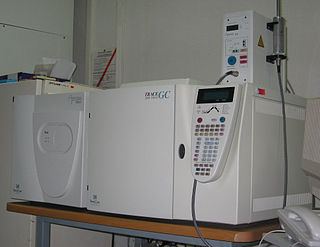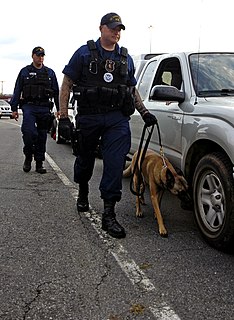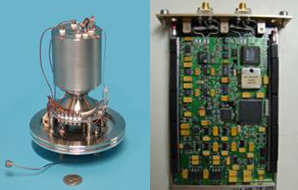After the September 11 attacks, questions were raised regarding the effectiveness of airport security at the time, as all 19 hijackers involved in 9/11 managed to pass existing checkpoints and board the airplanes without incident. In the months and years following September 11, 2001, security at many airports worldwide was escalated to deter similar terrorist plots.

The Transportation Security Administration (TSA) is an agency of the U.S. Department of Homeland Security that has authority over the security of the traveling public in the United States. It was created as a response to the September 11 attacks under the administration of President George W. Bush, to improve airport security procedures and centralize air travel security under a single federal agency.

Airport security refers to the techniques and methods used in an attempt to protect passengers, staff, aircraft, and airport property from accidental/malicious harm, crime, terrorism, and other threats.

The 2001 shoe bomb attempt was a failed bombing attempt that occurred on December 22, 2001, on American Airlines Flight 63. The aircraft, a Boeing 767-300ER with 197 passengers and crew aboard, was flying from Charles de Gaulle Airport in Paris, France to Miami International Airport in the U.S. state of Florida.

Gas chromatography–mass spectrometry (GC-MS) is an analytical method that combines the features of gas-chromatography and mass spectrometry to identify different substances within a test sample. Applications of GC-MS include drug detection, fire investigation, environmental analysis, explosives investigation, and identification of unknown samples, including that of material samples obtained from planet Mars during probe missions as early as the 1970s. GC-MS can also be used in airport security to detect substances in luggage or on human beings. Additionally, it can identify trace elements in materials that were previously thought to have disintegrated beyond identification. Like liquid chromatography–mass spectrometry, it allows analysis and detection even of tiny amounts of a substance.

Backscatter X-ray is an advanced X-ray imaging technology. Traditional X-ray machines detect hard and soft materials by the variation in x-ray intensity transmitted through the target. In contrast, backscatter X-ray detects the radiation that reflects from the target. It has potential applications where less-destructive examination is required, and can operate even if only one side of the target is available for examination.
Security theater is the practice of taking security measures that are intended to provide the feeling of improved security while doing little or nothing to achieve it. An example of security theater includes tightened airport security measures in the aftermath of the September 11 attacks.

Ion mobility spectrometry (IMS) is an analytical technique used to separate and identify ionized molecules in the gas phase based on their mobility in a carrier buffer gas. Though heavily employed for military or security purposes, such as detecting drugs and explosives, the technique also has many laboratory analytical applications, including the analysis of both small and large biomolecules. IMS instruments are extremely sensitive stand-alone devices, but are often coupled with mass spectrometry, gas chromatography or high-performance liquid chromatography in order to achieve a multi-dimensional separation. They come in various sizes, ranging from a few millimeters to several meters depending on the specific application, and are capable of operating under a broad range of conditions. IMS instruments such as microscale high-field asymmetric-waveform ion mobility spectrometry can be palm-portable for use in a range of applications including volatile organic compound (VOC) monitoring, biological sample analysis, medical diagnosis and food quality monitoring. Systems operated at higher pressure are often accompanied by elevated temperature, while lower pressure systems (1-20 hPa) do not require heating.

Explosive detection is a non-destructive inspection process to determine whether a container contains explosive material. Explosive detection is commonly used at airports, ports and for border control.
Explosives trace detectors (ETD) are explosive detection equipment able to detect explosives of small magnitude. The detection is accomplished by sampling non-visible "trace" amounts of particulates. Devices similar to ETDs are also used to detect narcotics. The equipment is used mainly in airports and other vulnerable areas considered susceptible to acts of unlawful interference. Dr. Stephen Lee is credited with inventing the Fido explosives detector while working at the Army Research Laboratory.
The CTX is an explosive detection device, a family of x-ray devices developed by InVision Technologies in 1990 that uses CAT scans and sophisticated image processing software to automatically screen checked baggage for explosives.

A full-body scanner is a device that detects objects on or inside a person's body for security screening purposes, without physically removing clothes or making physical contact. Depending on the technology used, the operator may see an alternate-wavelength image of the person's naked body, merely a cartoon-like representation of the person with an indicator showing where any suspicious items were detected or full X-ray image of the person. For privacy and security reasons, the display is generally not visible to other passengers, and in some cases is located in a separate room where the operator cannot see the face of the person being screened. Unlike metal detectors, full-body scanners can detect non-metal objects, which became an increasing concern after various airliner bombing attempts in the 2000s. Transmission X-ray body scanners can also detect swallowed items or hidden in body cavities of a person.

A millimeter wave scanner is a whole-body imaging device used for detecting objects concealed underneath a person’s clothing using a form of electromagnetic radiation. Typical uses for this technology include detection of items for commercial loss prevention, smuggling and screening at government buildings and airport security checkpoints. Several countries employ the scanners for security screening.
The concept of border security in the United States shares a complex relationship with the persistent threat of terrorism. Border security includes the protection of land borders, ports, and airports. The relationship is unique in the sense that the federal government must constantly reevaluate and tweak its border security policy to address the perceived threats posed to the United States through the form of human terrorism or the smuggling and detonation of a weapon of mass destruction.

A Visible Intermodal Prevention and Response team, sometimes Visible Intermodal Protection and Response (VIPR) is a Transportation Security Administration program. Various government sources have differing descriptions of VIPR's exact mission. It is specifically authorized by 6 U.S.C. § 1112 which says that the program is to "augment the security of any mode of transportation at any location within the United States". Authority for the program is under the Secretary of Homeland Security. The program falls under TSA's Office of Law Enforcement/Federal Air Marshal Service. TSA OLE/FAMS shares responsibility for the program with the Office of Security Operations and Transportation Sector Network Management.
A surgically implanted improvised explosive device (SIIED) is an explosive device hidden inside the body of a person in order to commit a suicide attack. This type of terrorist weapon, more commonly known as Body Cavity Bomb (BCB), is only known to have been used once, in a failed assassination attempt.

A miniature mass spectrometer (MMS) is a type of mass spectrometer (MS) which has small size and weight and can be understood as a portable or handheld device. Current lab-scale mass spectrometers however, usually weigh hundreds of pounds and can cost on the range from thousands to millions of dollars. One purpose of producing MMS is for in situ analysis. This in situ analysis can lead to much simpler mass spectrometer operation such that non-technical personnel like physicians at the bedside, firefighters in a burning factory, food safety inspectors in a warehouse, or airport security at airport checkpoints, etc. can analyze samples themselves saving the time, effort, and cost of having the sample run by a trained MS technician offsite. Although, reducing the size of MS can lead to a poorer performance of the instrument versus current analytical laboratory standards, MMS is designed to maintain sufficient resolutions, detection limits, accuracy, and especially the capability of automatic operation. These features are necessary for the specific in-situ applications of MMS mentioned above.

The National Explosives Detection Canine Team Program is a program administered by the Transportation Security Administration which uses law enforcement and TSA-run explosive detection dog teams to detect explosives in transportation environments.
Airport privacy involves the right of personal privacy for passengers when it comes to screening procedures, surveillance, and personal data being stored at airports. This practice intertwines airport security measures and privacy specifically the advancement of security measures following the 9/11 attacks in the United States and other global terrorist attacks. Several terrorist attacks, such as 9/11, have led airports all over the world to look to the advancement of new technology such as body and baggage screening, detection dogs, facial recognition, and the use of biometrics in electronic passports. Amidst the introduction of new technology and security measures in airports and the growing rates of travelers there has been a rise of risk and concern in privacy.

Lorne Elias is a Canadian chemist, inventor, and a pioneer in explosives detection technology. He invented the explosives vapour detector, EVD-1, a portable bomb detection instrument deployed at international airports in Canada in the 1980s. He contributed to the field of explosives detection for over three decades, and is called the father of vapour and trace explosives detection technology.











